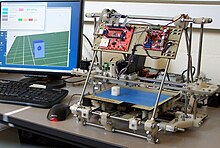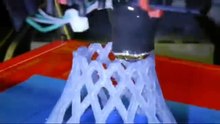RepRap
The RepRap is a 3D printer that can be used for rapid prototyping and rapid manufacturing and can also produce all plastic parts of its components yourself ( auto replication ). The name RepRap stands for Rep licating Rap id-prototyper. The plans for the device and the necessary software are under the GNU General Public License .
The idea
Adrian Bowyer invented and developed the idea of RepRap and has documented it in detail.
He placed his constructions under the GNU General Public License with the aim of achieving the widest possible distribution. The pure material costs for the first version of the RepRap were around € 500. This means that the machine should be buildable and usable for as many people as possible.
Another important aspect of his philosophy is the replicability of the construction. At least under European patent law, the reproduction of patented constructions for personal use is allowed, so for the self-builder, a conflict between the printer, which is composed exclusively of self-printed parts and standard parts (e.g. screws), and any patents that may exist is excluded from the outset. Replicability also allows minor changes to be made quickly and easily in the manufacture of the child printer, so that a further development similar to biological evolution can take place. The third aspect of replicability is that as the number of printers increases, the price of each device could decrease.
functionality
The RepRap works on the principle of melt stratification and the documentation was first published in 2008. It consists of a lifting platform , above which a printhead mounted on two axes sits; this moves from the coordinates at which the object to be created should contain material. In doing so, he melts a thin, usually 1.75 mm thick, plastic strand and pushes it out of a print head with an opening of well under a millimeter. Thermoplastics such as polylactide or acrylonitrile-butadiene-styrene are used . For further layers, the lift is lowered by the thickness of the applied material.
development
Darwin
In September 2006, the prototype of the RepRap 0.2 created a part of itself for the first time, which was installed directly. A RepRap version 1.0 (“Darwin”) replicated all of its plastic components for the first time in May 2008. Additional components cost around € 400 in the hardware store. Since extensions and improvements can be made by the machine itself, as soon as the corresponding parts have been designed on the computer, you can always bring the machine up to date, similar to software updates.
After a few minutes, the first offspring had printed out the part of another RepRap.
Mendel
Version 2 (Mendel) was published in October 2009 . The third version is a scaled down version of Mendel and should be able to be replicated faster and cheaper.
This model has a machine bed that, unlike its predecessor, cannot move vertically, but instead moves on the Y-axis. The print head, on the other hand, moves on the X and Z axes. The design is more compact and requires less material to manufacture.
The Prusa Mendel model is very similar in terms of functionality to the classic Mendel and is based on its concept, but its mechanical structure is much simpler.
Prusa Mendel (iteration 2)
The second iteration loop was completed in November 2011 and included upgrades such as snap-fit parts, a minimization of tools required for manufacturing and maintenance, and better belt drives attached to the stepper motors and LM8UU linear bearings.
Prusa i3
The third iteration loop led to the Prusa i3 in May 2012 and to its variant Prusa i3 MK2 in May 2016 .
Rostock
In contrast to the Mendel and Darwin 3D printers, the Rostock's extruder is not moved via a rail system, but with the help of three arms. The three arms are each controlled by a stepper motor that moves the arms in 3 dimensions via a belt.
Modifications
A heating bed can improve the quality of the products: When processing acrylonitrile-butadiene-styrene, large parts are warped. To prevent this, the printing surface is heated. The current electronics and the current software are already set up for this.
A rapid expansion of the range of models has been taking place since around mid-2011. In mid-2013 there were around 500 known variations. The centrally organized development of a common printer model was largely abandoned. Sales, especially the electronics required, are currently (mid-2013) via around 100 independent internet shops located in virtually all parts of the world.
Since the manufacture of self-replicating printers only requires little manual skills and changes or even new designs can be tried out very quickly, there is no end in sight to this development. Likewise, there are already designs of printers that use a process other than that of fused layering. Further developed versions of the RepRap should also include parts of the electronics, e.g. B. can produce the circuit boards .
See also
Web links
- Official website
- The universal machine , article by Florian Rötzer in Telepolis , June 7, 2005
Individual evidence
- ↑ RepRap About: about the RepRap project, its development and its philosophy.
- ↑ Werner Pluta: RepRap - 3D printer builds itself . In: Golem.de . June 4, 2008
- ↑ Jens Uehlecke: From the toothbrush to the digital camera . In: Time Knowledge . 02/2007, p. 88
- ↑ Hobbyist Weekend - With Prusa Mendel 3D Printer .
- ^ RepRap Family Tree
- ^ RepRap Buyers' Guide



